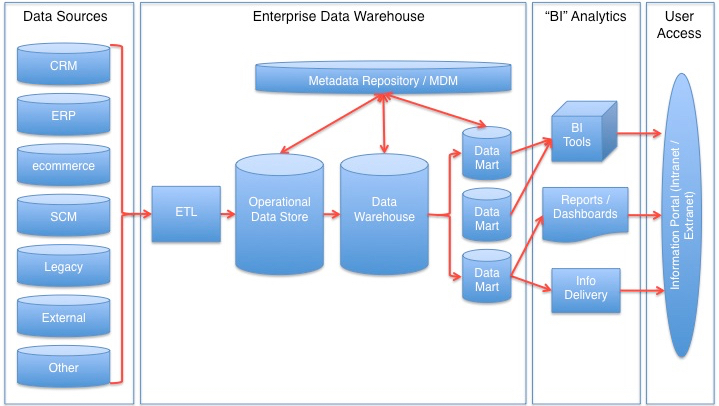Skip Navigation
An operational data store (ODS) is a central database that provides a snapshot of the latest data from multiple transactional systems for operational reporting. It enables organizations to combine data in its original format from various sources into a single destination to make it available for business reporting.
An ODS contains up-to-date information integrated from operational sources, and supports business intelligence (BI) tools that aid in tactical decision-making. For example, an administrator can set up an ODS to pull weekly batches of data from a rarely updated billing application, ingest individual transaction records as they occur in a sales database (thanks to triggers within that database), then combine both into new relational tables. Querying and reporting on operational data in an ODS thus comes with a guarantee that these integrated tables contain the most recent, relevant snapshot of the enterprise.
Learn more about the latest generation of ETL
Operational data store benefits
An ODS provides current, clean data from multiple sources in a single place, and the benefits apply primarily to business operations.
- The ODS provides a consolidated repository into which previously isolated or inefficiently communicating IT systems can feed.
- ODS reporting, which is focused on a snapshot of operational data, can be more sophisticated than reports from individual underlying systems. The ODS is architected to provide a consolidated view of data integrated from multiple systems, so reports can provide a holistic perspective on operational processes.
- The up-to-date view into operational status also makes it easier for users to diagnose problems before digging into component systems. For example, an ODS enables service representatives to immediately find a customer order, its status, and any troubleshooting information that might be helpful.
- An ODS contains critical, time-sensitive business rules, such as those automatically notifying a financial institution when a customer has overdrawn an account. These rules, in aggregate, are a kind of process automation that greatly improves efficiency, which would be impossible without current and integrated operational data.
Operational data stores and data warehouses: the differences
An ODS is designed for a different purpose than a data warehouse.
- An ODS may be used as an interim area for a data warehouse; it sits between the data sources and the data warehouse.
- An ODS is designed to perform simple queries on small sets of data, while a data warehouse is designed to perform complex queries on large sets of data.
- An ODS deals exclusively with current operational data and basic status-level reporting, because an ODS continuously overwrites data. A data warehouse continually inserts records into existing tables and can aggregate data across historical views.

Data warehouse reference architecture: DataZoomers
Businesses use a data warehouse's centralized repository to inform enterprise-wide strategies, while the ODS is more tactical. Depending on use cases and business requirements, organizations may use one or the other, or both together within a tiered data architecture.
Businesses that need aggregated historical data for analytics often set up a complementary data warehouse. Similarly, if a business with a data warehouse needs current, integrated operational data for day-to-day functioning, it can implement an ODS.
Let Stitch increase your data flexibility and accessibility today
Take, for example, an online store with a billing system that records customer information (name, address, shipping preferences) and a transaction system that tracks customer purchases as they occur. Users can query the ODS for a live operational view ("how much product was purchased in the last hour?") or reports that answer tactical questions ("which geographical regions are responsible for the most revenue today?"). But users would query the data warehouse to generate reports that highlight business trends over longer periods of time.
Get started with an operational data store
When setting up an ODS, you'll need to replicate the data from your sources into your destination. This data replication process is called ETL (extract, transform, load), and Stitch has a tool that makes the process simple. In fact, you won't need the "T" part, because the goal of an ODS is to preserve the format of the operational source. Sign up for a free trial and use Stitch to replicate and integrate data throughout your data storage architecture.
Give Stitch a try, on us
Stitch streams all of your data directly to your analytics warehouse.
Set up in minutesUnlimited data volume during trial